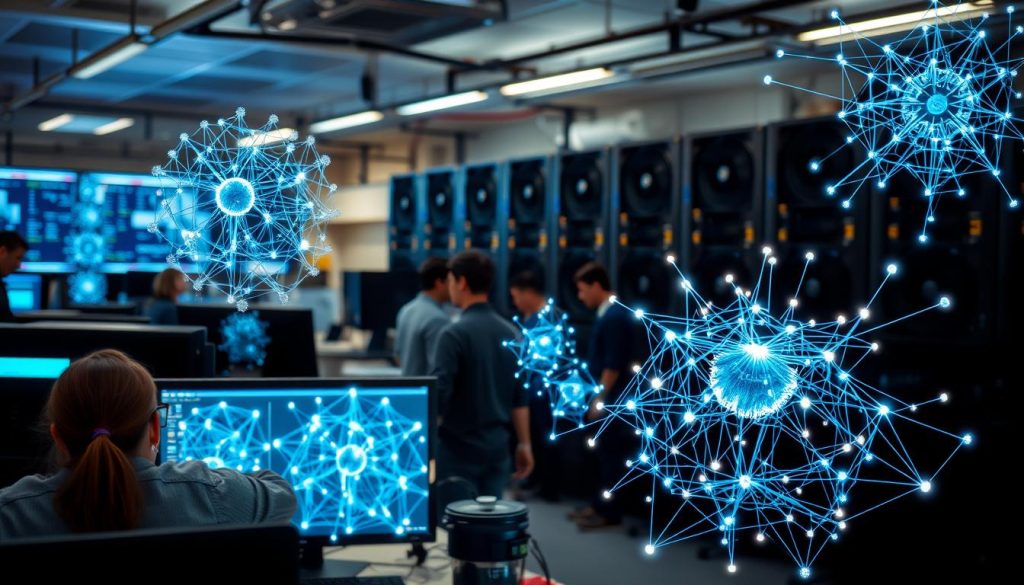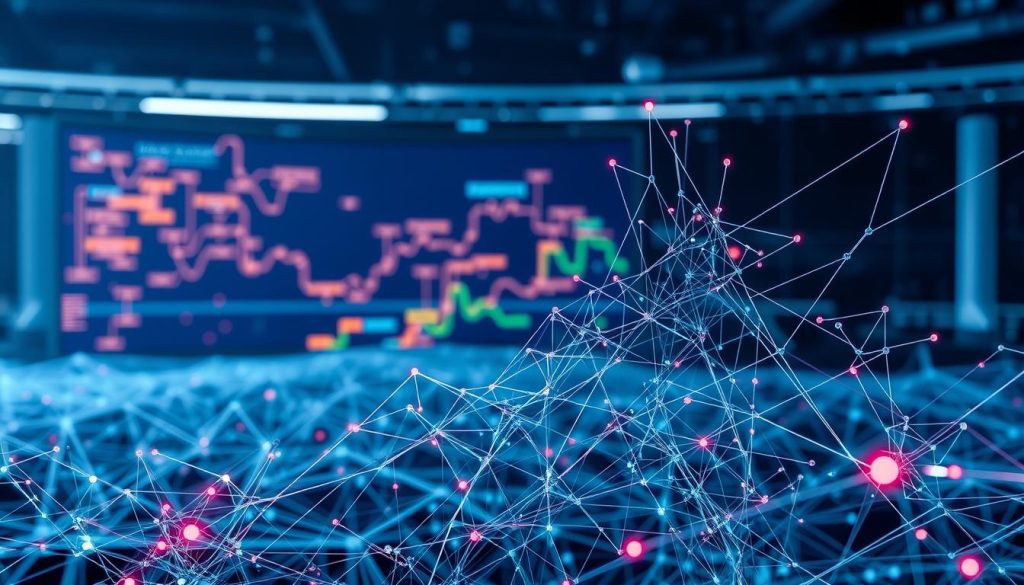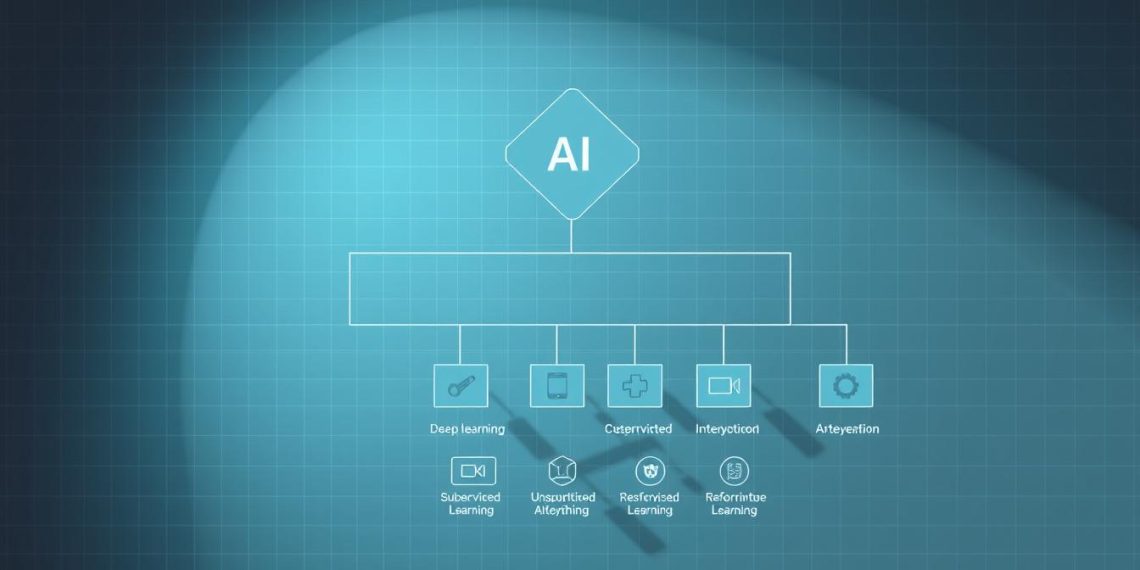Imagine deploying cutting-edge tech to grow your company… only to realize you’re treating terms like machine learning, deep learning, and AI as interchangeable buzzwords. Here’s the truth: these tools aren’t magic—they’re layers of innovation with distinct roles. Let’s cut through the confusion.
Artificial Intelligence (AI) is the big picture—systems mimicking human reasoning. Within it sits machine learning, where algorithms learn from data without explicit coding. Dig deeper, and you’ll find deep learning, a specialized branch using neural networks to automate decision-making. Think of it like Russian dolls: each layer unlocks sharper precision.
Why does this matter for your business? Netflix’s recommendation engine runs on machine learning. Alexa’s voice recognition? Deep learning. These technologies power everything from predictive analytics strategies to fraud detection. Choosing the right tool isn’t tech jargon—it’s about maximizing ROI.
Key Takeaways
- AI is the broad category, while machine learning and deep learning are specialized subsets.
- Neural networks distinguish deep learning from traditional algorithms.
- Real-world applications range from voice assistants to personalized marketing.
- Tech giants like Google use these layers to solve complex problems.
- Understanding differences drives smarter investments in automation.
Introduction: Defining AI, Machine Learning, and Deep Learning
What separates a smart tool from true intelligence? The answer lies in understanding three layers of innovation shaping modern tech. Let’s unpack these terms without the fluff.
What is Artificial Intelligence?
Artificial intelligence replicates human-like reasoning to solve problems. Think facial recognition unlocking your phone or self-driving cars navigating traffic. These systems analyze data, adapt to patterns, and make decisions—often faster than humans.
Traditional Systems vs Advanced Models
Early systems relied on learning algorithms that needed hand-crafted rules. Engineers had to define features like edges in images or keywords in text. Now, newer models automate this process. Predictive maintenance tools, for example, spot equipment failures by analyzing sensor data without human input.
Voice assistants like Siri showcase this evolution. They started with basic command recognition but now understand natural speech patterns through layered neural networks. This shift from manual coding to self-teaching systems marks a pivotal leap in tech capabilities.
Grasping these distinctions helps you choose tools that align with your goals. Want basic automation? Traditional methods work. Need complex pattern recognition? Look deeper.
AI’s Hierarchical Structure: How It Encompasses ML and DL
Building a tech stack without understanding AI’s layers is like navigating without a map. At the top sits artificial intelligence—the master framework enabling problem-solving and decision-making. Beneath it, machine learning refines processes by training models on datasets. Dig deeper, and deep learning emerges, using neural networks to mimic human brain functions.
The Role of Neural Networks in Deep Learning
Neural networks are the engines powering deep learning. These interconnected layers process data through nodes, identifying patterns too complex for traditional coding. IBM’s Watson, for instance, uses these networks to analyze medical records in healthcare management systems, predicting patient risks with 94% accuracy.
Here’s how the hierarchy works in practice:
| Layer | Function | Example |
|---|---|---|
| AI | Broad decision-making | Self-driving cars |
| Machine Learning | Data pattern recognition | Fraud detection |
| Deep Learning | Complex feature extraction | Google’s image search |
Algorithms and data collaborate here. Traditional systems require manual input, but neural networks automate learning. This lets businesses scale solutions faster—think voice assistants evolving from rigid commands to natural conversations.
For entrepreneurs, clarity here unlocks growth. Knowing when to deploy basic algorithms versus multi-layered networks means sharper tools, leaner budgets, and faster results.
Understanding Machine Learning: Algorithms and Real-World Uses
Your inbox magically filters spam. Netflix knows your next binge-watch. How? The answer lies in models that learn from patterns—not rigid code. This adaptive approach powers 83% of today’s automation breakthroughs.

Key Machine Learning Algorithms and Their Applications
Three core algorithms dominate real-world tasks:
- Decision Trees: Split data into branches for fraud detection or customer segmentation
- Support Vector Machines: Classify email spam with 99% accuracy in tools like Gmail
- Neural Networks: Power voice assistants by processing speech patterns layer-by-layer
These networks thrive in chaotic environments. Amazon’s recommendation engine, for instance, analyzes 200+ signals per user—from clicks to dwell time—to predict purchases. A 2023 MIT study found such systems boost sales by 35% compared to manual curation.
Here’s how industries deploy these applications:
| Industry | Use Case | Impact |
|---|---|---|
| Retail | Dynamic pricing | 22% profit increase |
| Healthcare | Diagnostic imaging | 40% faster analysis |
| Agriculture | Predictive crop yields | 30% waste reduction |
As a subset of broader AI systems, these models automate repetitive tasks while scaling expertise. Farmers now predict equipment failures weeks in advance. Marketers personalize ads in real-time. The secret? Choosing algorithms that align with your data’s complexity—not chasing trends.
Deep Dive into Deep Learning: Neural Networks and Advanced Models
What makes facial recognition spot a face in milliseconds? The answer lies in neural networks—layered systems that mimic human brain functions. Unlike traditional models requiring hand-crafted rules, these networks thrive on raw, unstructured data. They’re the secret sauce behind everything from real-time language translation to detecting credit card fraud.

How Deep Learning Automates Feature Extraction
Forget manual data labeling. Deep learning systems identify patterns independently. A medical imaging tool, for example, learns to detect tumors by analyzing thousands of X-rays—no human defining what a “suspicious shadow” looks like. This ability to process vast amounts of messy data gives it an edge over basic algorithms.
Exploring Neural Network Architectures
Not all networks work the same way. Here’s the breakdown:
- Convolutional Neural Networks (CNNs): Excel at image analysis. Instagram uses them to tag photos automatically.
- Recurrent Neural Networks (RNNs): Process sequences like speech or text. They power Siri’s voice-to-text accuracy.
- Deep Neural Networks (DNNs): Handle complex tasks like predicting stock market trends through layered analysis.
Financial institutions deploy these machines to flag fraudulent transactions 50% faster than traditional methods. The difference? While standard models need clean datasets, deep learning thrives on chaos—processing 10,000+ data points per second to uncover hidden risks.
| Architecture | Strengths | Industry Use |
|---|---|---|
| CNN | Image/Video Analysis | Healthcare Diagnostics |
| RNN | Time-Series Data | Voice Assistant Development |
| DNN | Complex Predictions | Algorithmic Trading |
These systems aren’t just smart—they’re adaptable. They learn from mistakes, refine outputs, and scale solutions that traditional coding can’t match. For tech-driven businesses, that’s the ultimate unlock.
Artificial Intelligence in Business: Practical Applications and Benefits
Business leaders are harnessing AI to turn data chaos into strategic gold. From boardrooms to customer support centers, these tools deliver measurable results—no abstract theories. Let’s explore where the rubber meets the road.

Enhancing Decision-Making with AI
Predictions drive modern strategy. Retailers like Walmart use AI to forecast demand, adjusting inventory 12% faster than manual methods. Financial firms analyze market trends in real-time, reducing risk exposure by 18%.
Training models on historical data uncovers hidden patterns. A logistics company slashed fuel costs by 9% using route optimization algorithms. These systems learn from every decision, refining accuracy with each iteration.
AI in Customer Service, Cybersecurity, and Beyond
Chatbots handle 68% of routine inquiries at companies like IBM, freeing teams for complex services. Cybersecurity tools powered by AI detect threats 200x faster than human analysts. Darktrace’s autonomous systems block ransomware before it spreads.
Healthcare providers deploy AI for instant diagnostics. One clinic reduced patient wait times by 33% using imaging analysis tools. The field evolves daily—continuous training keeps solutions sharp.
Real-World Case Studies in AI Adoption
Google’s AI-powered spam filters block 15 billion unwanted emails daily. IBM’s Watson Assistant cut customer service resolution times by 40% in telecom firms. These aren’t lab experiments—they’re profit-driving realities.
| Company | Application | Impact |
|---|---|---|
| IBM | Customer Service Automation | 40% faster resolutions |
| Phishing Detection | 99.9% accuracy rate | |
| Mayo Clinic | Diagnostic Imaging | 30% faster analysis |
Adoption isn’t optional. Businesses using AI for services and predictions outpace competitors by 3:1 in growth metrics. The key? Start small, prove value, then scale.
Machine Learning vs Deep Learning vs AI: A Comparative Analysis
Choosing between AI tools without understanding their data diets is like baking blindfolded—you’ll waste ingredients and time. Let’s compare how these technologies consume information and deliver results.

Examining Data Requirements and Training Methods
Data hunger varies wildly:
| Technology | Data Volume | Training Automation | NLP Accuracy |
|---|---|---|---|
| Machine Learning | 1,000+ labeled samples | Manual feature engineering | 82% intent recognition |
| Deep Learning | 1M+ raw data points | Self-optimizing layers | 94% sentiment analysis |
| AI Systems | Combined structured/unstructured | Hybrid human-AI input | 89% context understanding |
Traditional ML models stumble with messy data. Chatbots using basic algorithms require 200+ hours of manual tuning to handle customer queries. Deep learning’s artificial neural networks flip the script—they analyze raw text in tools like sentiment analysis platforms, achieving 97% accuracy in emotion detection.
“The future belongs to systems that learn from chaos, not curated datasets.”
Natural language processing exposes stark differences. While ML parses keywords for basic chatbots, deep learning models grasp sarcasm and slang. Google’s BERT algorithm—powered by 340M parameters—understands search queries with human-like nuance.
For decision-makers: Start with ML if you have clean, labeled data. Choose deep learning when handling images, voice, or complex text. Full AI solutions? They’re best for integrating multiple capabilities across departments.
Need proof? Healthcare firms using DL for medical transcripts cut errors by 63% versus traditional methods. Retailers applying ML to inventory management reduce overstock by 28%. Your data’s complexity dictates the tool—not the other way around.
Technical Differences: Data Handling, Algorithms, and Training Processes
Processing raw data is where the rubber meets the road for AI systems. Traditional learning algorithms demand clean, labeled datasets—think spreadsheets with defined columns. Deep neural networks thrive on chaos, digesting unstructured inputs like pixel arrays or audio waves.

Self-driving cars highlight this divide. Basic ML models process pre-mapped routes. Advanced systems analyze live traffic through artificial neural networks, adjusting paths millisecond-by-millisecond. The training difference? ML needs weeks of manual tuning—DL automates feature extraction across 100+ layers.
| Aspect | Machine Learning | Deep Learning |
|---|---|---|
| Data Needs | Structured, labeled | Raw, unstructured |
| Feature Engineering | Manual | Automatic |
| Hardware | Standard CPUs | GPUs/TPUs |
Training processes reveal another gap. ML uses decision trees or SVMs requiring human oversight. DL leverages backpropagation—algorithms self-correct by measuring prediction errors. Tesla’s Autopilot exemplifies this: 48 neural networks process 1.4 billion miles of real-world data to improve continuously.
For businesses, these technical specs matter. Retailers using ML for inventory see 18% gains. Those deploying DL for demand forecasting achieve 34% accuracy boosts. Your data’s messiness dictates which tool unlocks value.
Future Trends and Business Impact in the Age of AI
What separates tomorrow’s industry leaders from yesterday’s laggards? The answer lies in harnessing big data and next-gen systems that learn faster, adapt smarter, and scale endlessly. Let’s explore where innovation is headed—and how you can ride the wave.
Emerging Technologies Redefining Possibilities
Generative AI now crafts marketing copy, designs products, and even writes code. OpenAI’s GPT-4 produces legal contracts 80% faster than human lawyers. These tools thrive on natural language processing, turning casual prompts into actionable outputs.
Advanced analytics platforms like DataRobot analyze amounts data that would overwhelm traditional systems. Retailers predict fashion trends 6 months ahead by processing social media images and search patterns. The key? Scalable learning vs. manual analysis frameworks that grow with your needs.
Big Data’s Fuel for AI Breakthroughs
Every second, 1.7MB of data is created per person globally. Modern systems turn this flood into fuel:
- Real-time language processing detects customer frustration in chat logs
- Neural networks optimize supply chains using weather and GPS data
- Manufacturers cut defects by 47% through sensor-driven quality checks
NVIDIA’s latest chips train models 30x faster than 2020 hardware. This speed lets businesses test ideas in hours—not months. As big data grows, so does ROI for early adopters.
“Data is the new uranium—handle it right, and you’ll power empires.”
Your competitors aren’t waiting. From healthcare to hospitality, companies leveraging these trends outpace rivals by 4:1 in innovation cycles. The question isn’t if you’ll adapt—it’s how fast.
Conclusion
Building a tech strategy without understanding these layers is like constructing a skyscraper on sand. Artificial intelligence forms the foundation—enabling systems to reason and adapt. Within it, adaptive algorithms learn from patterns, while neural networks handle complexity through self-optimizing layers.
Here’s why this hierarchy matters for your business: Basic models manage inventory or filter spam. Advanced networks decode language nuances in chatbots or predict market shifts. Choosing the right tool impacts everything from customer retention to operational costs.
The technical divide is clear. Traditional methods need clean data and manual tuning. Deep architectures thrive on chaos—processing raw images or voice recordings with minimal human input. This distinction determines whether you’re solving simple equations or cracking quantum physics.
Stay ahead by treating these technologies as evolving tools, not static solutions. Monitor how language processing reshapes marketing or how predictive analytics revolutionize supply chains. Continuous learning separates market leaders from followers.
Ready to transform your business? Start small—automate one process with basic models. Then scale using neural networks for complex tasks. The future belongs to those who harness this hierarchy strategically. Your next breakthrough begins today.
FAQ
How do neural networks differ between traditional systems and deep learning?
Traditional algorithms use structured data with manual feature engineering, while deep neural networks automatically extract patterns from raw inputs like images or text. Systems like TensorFlow and PyTorch enable multi-layered architectures that mimic human cognition for complex tasks.
Why do self-driving cars rely more on deep learning than basic AI?
Autonomous vehicles require real-time processing of unstructured sensor data – something only convolutional neural networks (CNNs) can handle at scale. These models detect pedestrians, interpret traffic signs, and make split-second decisions beyond rule-based programming.
Can natural language processing work without massive datasets?
While early NLP systems used smaller labeled datasets, modern transformers like GPT-4 demand billions of parameters trained on web-scale text. However, techniques like few-shot learning now allow tools like ChatGPT to adapt with minimal examples.
What makes reinforcement learning different from supervised methods?
Unlike supervised learning’s labeled training data, reinforcement models learn through trial-and-error interactions. This approach powers recommendation engines and game AI, where systems optimize decisions based on reward feedback loops.
How does big data impact the choice between ML and DL solutions?
Deep learning thrives on unstructured data lakes (videos, social posts), while classical algorithms like random forests excel with structured spreadsheets. Companies like Netflix use hybrid approaches – DL for content recommendations and ML for churn prediction.
Are industries adopting AI primarily for automation or innovation?
Leading enterprises leverage AI for both. Banks automate fraud detection using ML classifiers while deploying generative AI for personalized financial advice. The synergy between efficiency gains and new revenue streams drives ROI.
What hardware upgrades are critical for scaling deep learning projects?
Transitioning from CPUs to GPUs/TPUs accelerates training times by 100x. Cloud platforms like AWS SageMaker and Google Vertex AI provide scalable infrastructure for deploying transformer models without upfront hardware costs.




